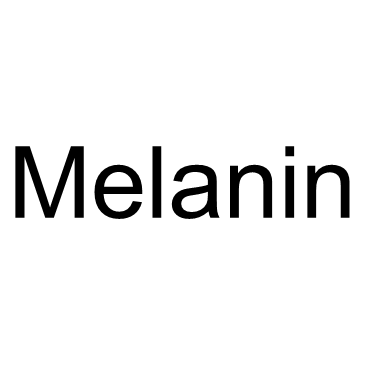Melanin

Melanin structure
|
Common Name | Melanin | ||
|---|---|---|---|---|
| CAS Number | 8049-97-6 | Molecular Weight | 318.28300 | |
| Density | 1.65g/cm3 | Boiling Point | 500.5ºC at 760 mmHg | |
| Molecular Formula | C18H10N2O4 | Melting Point | N/A | |
| MSDS | Chinese USA | Flash Point | 195.4ºC | |
|
Testing in mice the hypothesis that melanin is protective in malaria infections.
PLoS ONE 7 , e29493, (2012) Malaria has had the largest impact of any infectious disease on shaping the human genome, exerting enormous selective pressure on genes that improve survival in severe malaria infections. Modern humans originated in Africa and lost skin melanization as they m... |
|
|
Identification of quinolines that inhibit melanogenesis by altering tyrosinase family trafficking.
Mol. Pharmacol. 74 , 1576-86, (2009) A series of quinolines, including chloroquine and quinine, were identified as potent pigmentation inhibitors through screening a compound library in murine melanocytes. Structure-activity relationship analysis indicated that 4-substituted amino groups with a ... |
|
|
Ex vivomodels to evaluate the role of ocular melanin in trans-scleral drug delivery
Eur. J. Pharm. Sci. 46(5) , 475-83, (2012) Trans-scleral delivery is nowadays considered as a possible way to deliver drugs to the posterior segment of the eye. Despite the potentiality of this administration route, there is a lack of fundamental knowledge on the role of the numerous barriers involved... |
|
|
Cerenkov Luminescence Imaging for Accurate Placement of Radioactive Plaques in Episcleral Brachytherapy of Intraocular Tumors.
Invest. Ophthalmol. Vis. Sci. 56 , 7362-8, (2015) The purpose of this study was to determine the feasibility of using Cerenkov luminescence imaging (CLI) to facilitate plaque placement during episcleral brachytherapy of intraocular tumors.Ruthenium-106 (Ru-106) decays to rhodium-106, which in turn emits high... |
|
|
Spiders do have melanin after all.
J. Exp. Biol. 218 , 3632-5, (2015) Melanin pigments are broadly distributed in nature - from bacteria to fungi to plants and animals. However, many previous attempts to identify melanins in spiders were unsuccessful, suggesting that these otherwise ubiquitous pigments were lost during spider e... |
|
|
Singlet molecular oxygen generation by light-activated DHN-melanin of the fungal pathogen Mycosphaerella fijiensis in black Sigatoka disease of bananas.
PLoS ONE 9 , e91616, (2014) In pathogenic fungi, melanin contributes to virulence, allowing tissue invasion and inactivation of the plant defence system, but has never been implicated as a factor for host cell death, or as a light-activated phytotoxin. Our research shows that melanin sy... |
|
|
Vibrio campbellii hmgA-mediated pyomelanization impairs quorum sensing, virulence, and cellular fitness.
Front. Microbiol. 4 , 379, (2013) Melanization due to the inactivation of the homogentisate-1,2-dioxygenase gene (hmgA) has been demonstrated to increase stress resistance, persistence, and virulence in some bacterial species but such pigmented mutants have not been observed in pathogenic mem... |
|
|
Melanin-Like Pigment Synthesis by Soil Bacillus weihenstephanensis Isolates from Northeastern Poland.
PLoS ONE 10 , e0125428, (2015) Although melanin is known for protecting living organisms from harmful physical and chemical factors, its synthesis is rarely observed among endospore-forming Bacillus cereus sensu lato. Here, for the first time, we reported that psychrotolerant Bacillus weih... |